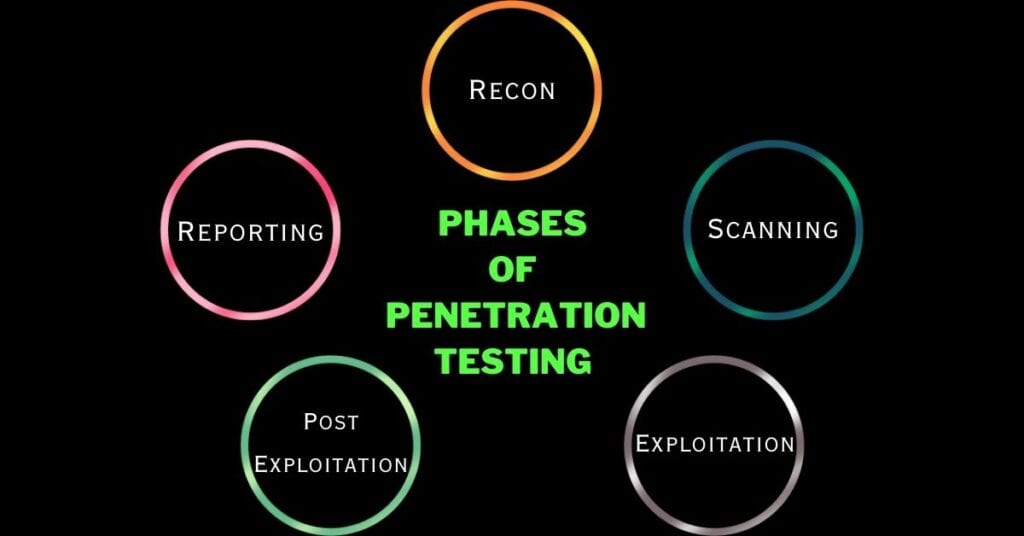Introduction:
Imagine you’re on a thrilling mission to protect important information from falling into the wrong hands. Just like these missions, organizations need to safeguard their digital systems. That’s where penetration testing comes in! In this blog, we’ll take you on an exciting journey through the five phases of penetration testing, explaining each step in a way that even a 5th-grade student can understand.
Phase 1: Reconnaissance – The Detective Work Begins
In this phase, the pentester turns into a digital detective, gathering information about the target system. It’s like trying to find hidden clues to solve a mystery! For example, if we were to assess the defenses of a famous superhero, Superman, we might search for public information about him, like his secret hideouts or weaknesses. Two popular tools used during this phase are:
- Shodan: A search engine for discovering devices connected to the internet.
- TheHarvester: A tool that gathers email addresses, subdomains, and other information from public sources.
Phase 2: Scanning – Disclosing Doors and Windows
Once the detective work is done, it’s time to scan the target system for potential entry points. It’s like searching for hidden doors and windows in a house. Just as a burglar tries to find an unlocked entrance, a pentester looks for open ports and services that could be exploited. Two commonly used tools for this phase are:
- Nmap: A powerful network scanning tool that identifies open ports and running services.
- Nessus: A vulnerability scanner that identifies security weaknesses in target systems.
Phase 3: Exploitation – Unlocking the System’s Secrets
Now comes the most thrilling part – Exploitation! It’s like discovering a secret passage to gain unauthorized access to the target system. Think of it as a treasure hunt, where a hacker finds a hidden path to reach the precious treasure. In the digital world, we use tools like the following to exploit vulnerabilities and demonstrate their impact:
- Metasploit Framework: An extensive exploitation framework that contains numerous exploit modules for various vulnerabilities.
- Burp Suite: A web application testing tool that helps identify and exploit web application vulnerabilities.
Phase 4: Post-Exploitation – Delving Deeper
Just like a secret agent who has successfully penetrated an enemy base, the pentester aims to dig deeper into the compromised system. We want to maintain access and explore the environment for valuable information. Picture a secret agent accessing hidden rooms, looking for important documents or passwords. Two commonly used tools for post-exploitation activities are:
- Mimikatz: A post-exploitation tool for extracting authentication credentials from compromised systems.
- PowerSploit: A collection of PowerShell scripts used for offensive security tasks, including privilege escalation and lateral movement.
Phase 5: Reporting – Sharing the Findings
After the adventure, it’s time to share our findings with the organization. We compile a report that explains the discovered vulnerabilities. The report is like a clear map that guides the organization on how to strengthen their defenses. This phase does not involve specific tools but focuses on effectively communicating the information gathered.
You may also like:
https://hackedyou.org/mobile-app-security-protecting-your-apps/
https://hackedyou.org/how-does-the-internet-work-simplified/
https://hackedyou.org/tcp-ip-model/
https://hackedyou.org/tcp-ip-vs-osi-model/
https://hackedyou.org/http-status-codes-explained-all/
https://hackedyou.org/what-is-a-cdn-and-how-does-it-work/
https://hackedyou.org/dns-resolver-explained/
https://hackedyou.org/understanding-network-topology/
https://hackedyou.org/10-important-browser-cookies/
https://hackedyou.org/everything-about-internet-cookies/
https://hackedyou.org/network-protocols-types-and-uses/
https://hackedyou.org/hackers-exploiting-open-ports/
https://hackedyou.org/client-server-model/
https://hackedyou.org/ip-addresses-basics-explained/
https://hackedyou.org/top-20-networking-fundamentals-for-hackers/
https://hackedyou.org/artificial-intelligence-transforming-cybersecurity/
https://hackedyou.org/top-10-major-cybersecurity-threats-in-2023/
https://hackedyou.org/mastering-cybersecurity-2023-ultimate-guide/






